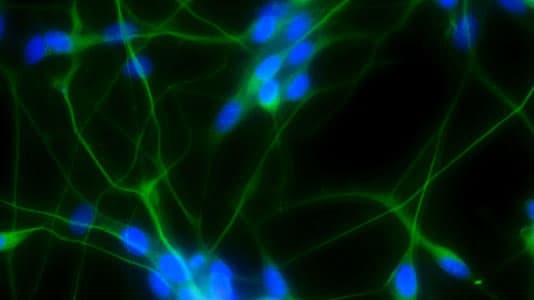Developing functional circuits from live nerve cells

The central nervous system is a highly complex network of intercommunicating cells, with specific populations of nerve cells 'talking' very precisely to each other to control our movements, thoughts and behaviours. Modelling of this network in the laboratory is highly desirable for areas such as drug screening, testing of toxins and understanding disease pathology. As an interdisciplinary scientist, one strand of Dr Paul Roach's research focuses on the development of ‘brain-on-a-chip’ devices, using living neurons to fabricate living electrical circuits.
The worldwide population is rapidly ageing, with a projected ~23% of people in the UK being above 65 years old by 2035. There is a strong link between ageing and the prevalence of neurodegenerative disease. The number of cases of neurological disease is projected to dramatically increase over the coming years, leading to an urgent need for advanced therapeutics and understanding of these disease processes. Existing treatments are extremely limited, and for the most part only treat presenting symptoms rather than act as a cure. New ways are needed to provide insight into neuronal tissue function, with assays in pharmaceutical discovery currently very limited to toxicology of individual cell populations rather than monitoring of tissue function.
Through the design of advanced materials and surface engineering approaches, Dr Roach's team is able to fabricate devices with grooves thinner than a human hair. These structures guide the connectivity of neurons, providing a means of creating designer neuronal circuitry. These devices can be used to form complex living neuronal networks from which we can better understand maturation of the developing cells within the circuit and the network as a whole. The team designs within the devices embedded electrodes to provide direct insight into the real-time function of these circuits - useful when considering how the function changes over time or the effect of pharmaceuticals or stem cells when these devices are used to model neurological disease.
This ‘brain-on-a-chip’ model allows for reproducible and robust study of the function of specific nerve cell circuitry within the laboratory. In this way, Dr Roach's hope is to provide a new tool for therapeutic discovery, whilst limiting the number of animals used in similar research. In collaboration with academics, clinicians and industrialists, this advanced bio-technology platform will also rapidly increase our knowledge of neurodegenerative diseases.
Dr Paul Roach's research interests build upon his interdisciplinary background spanning synthetic organic chemistry, materials science, experimental physics and instrumentation, and biological response to surface cues. He was appointed as a Senior Lecturer at Loughborough University in December 2016. His overall research aim is to combine his knowledge of chemical and bio‑surface engineering and development of novel instrumentation to revolutionise materials/devices used in healthcare.
